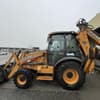Podcast
Questions and Answers
What is a key step to take before starting a skid steer?
What is a key step to take before starting a skid steer?
- Check the fuel level.
- Ensure the seatbelt is fastened and all attachments are secured. (correct)
- Adjust the seat position.
- Sign in on a log sheet.
Which technique helps maintain stability when driving a skid steer on slopes?
Which technique helps maintain stability when driving a skid steer on slopes?
- Drive uphill straight. (correct)
- Drive diagonally to reduce incline.
- Switch to reverse gear while driving uphill.
- Avoid using the joystick for steering.
What should be done when loading and unloading with a skid steer?
What should be done when loading and unloading with a skid steer?
- Use the machine's highest speed to lift loads quickly.
- Tilt the bucket back for stability when lifting. (correct)
- Load at a sharp angle for speed.
- Always unload on uneven surfaces.
What is the best practice for visibility while operating a skid steer?
What is the best practice for visibility while operating a skid steer?
Which of the following is NOT a recommended pre-operation check?
Which of the following is NOT a recommended pre-operation check?
Why is it important to familiarize yourself with attachments used on skid steers?
Why is it important to familiarize yourself with attachments used on skid steers?
What is an advisable action regarding personal protective equipment (PPE) when operating a skid steer?
What is an advisable action regarding personal protective equipment (PPE) when operating a skid steer?
What should trained operators ensure about communication while operating a skid steer?
What should trained operators ensure about communication while operating a skid steer?
Flashcards are hidden until you start studying
Study Notes
Skid Steers
Operating Techniques
-
Starting the Machine:
- Ensure the seatbelt is fastened and all attachments are secured.
- Check all controls for functionality before starting.
-
Driving:
- Use the joystick controls for precise movement.
- Practice slow movements to gain control.
- Use forward and reverse gears appropriately for terrain.
-
Turning:
- Utilize differential steering to turn sharply.
- For tight spaces, practice counter-rotation.
-
Loading and Unloading:
- Approach loads at a safe speed.
- Tilt the bucket back for stability when lifting.
- Always load and unload on flat surfaces to prevent tipping.
-
Attachments:
- Familiarize yourself with various attachments (e.g., buckets, forks).
- Ensure proper attachment connections and compatibility.
-
Operating on Slopes:
- Drive uphill straight to maintain stability.
- Avoid turning on slopes to prevent rollover.
-
Visibility:
- Check surroundings frequently.
- Use mirrors and cameras if equipped for better visibility.
Safety Protocols
-
Pre-Operation Checks:
- Inspect for fluid leaks, tire pressure, and overall equipment condition.
- Ensure all safety features (e.g., ROPS) are functional.
-
Personal Protective Equipment (PPE):
- Wear hard hats, steel-toed boots, gloves, and safety glasses.
- Use high-visibility clothing on site.
-
Communication:
- Establish clear signals with ground workers.
- Use radio communication if necessary.
-
Load Management:
- Never exceed the machine’s load capacity.
- Balance loads evenly to prevent tipping.
-
Operating Area:
- Keep the work area clear of obstacles and bystanders.
- Mark off zones for safe operation.
-
Emergency Procedures:
- Know the location of emergency shut-off switches.
- Have a plan for dealing with rollover and equipment failure.
-
Training:
- Only trained operators should use skid steers.
- Regularly refresh training to stay updated on best practices and safety.
Operating Techniques
- Starting requires fastening the seatbelt and securing all attachments for safety.
- Perform a functionality check on all controls before initiating operation.
- Joystick controls allow for precise movement; practice slow, deliberate motions increases control.
- Use appropriate forward and reverse gears based on terrain conditions.
- Differential steering facilitates sharp turns; counter-rotation is beneficial in tight spaces.
- Approach loads cautiously, tilting the bucket back during lift to ensure stability.
- Always load and unload on flat surfaces to minimize the risk of tipping over.
- Familiarize with various attachments, such as buckets or forks, confirming proper connections for safe use.
- Maintain straight direction while driving uphill to enhance stability; turning on slopes increases rollover risk.
- Regularly check surroundings for safety; utilize mirrors and cameras for enhanced visibility when available.
Safety Protocols
- Conduct pre-operation checks for fluid leaks, tire pressure, and overall equipment condition before use.
- Ensure all safety features, including Roll-Over Protective Structures (ROPS), are operational.
- Personal Protective Equipment (PPE) includes hard hats, steel-toed boots, gloves, safety glasses, and high-visibility clothing.
- Establish clear communication signals with ground workers and use radios when necessary for efficient teamwork.
- Adhere strictly to load management guidelines; never exceed load capacity and ensure loads are balanced to prevent tipping.
- Keep the operating area clear of obstacles and bystanders; designate marked zones for safety.
- Be aware of emergency procedures, including the location of emergency shut-off switches, and plan for potential rollover scenarios.
- Only trained operators should handle skid steers; regular training refreshers are essential to maintain safety standards and awareness.
Studying That Suits You
Use AI to generate personalized quizzes and flashcards to suit your learning preferences.



